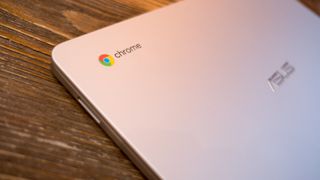Android 10 gesture navigation could be coming to Chrome OS
Swipe, swipe, swipe to get around

Android 10 finally introduced iPhone 11-like gesture navigation as an alternative to the tried-and-true three-button nav bar, and now it appears it could be coming to Chrome OS tablets and laptops as well.
Changes in Chrome OS's code – specifically, chrome://flags for navigation areas – suggests that the gesture navigation is coming to the operating system, according to 9to5Google. New design changes in the Chrome OS Dev channel release also add to the speculation, with a line at the bottom of the homescreen – very similar to Android 10’s gesture navigation bar.
The other gestures uncovered include back, overview, and homeview which, taken altogether, is hard not to see the unification of touch gestures across Google’s device software.
While some of these gestures aren’t brand new to Chrome OS and were possible previously, the code seems to suggest things like “back” are getting a more consistent implementation with dedicated screen real estate for touch navigation. This would match with Android 10, assuming that the same portion of side screen space will be used to go back and home.
For those who haven’t been able to try Android 10’s gesture navigation yet, it's very reminiscent of the touch gestures iOS uses for iPhone X and later, or the type that many smartphone manufacturers have used for user interfaces that lie over Android. A swipe up from the bottom goes to the homescreen, while back is used to go to the previous screen.
Gesture nav for Chromebooks and tablets
From a software-touch-device standpoint this transition seems obvious, but Google only announced it would be dropping its tablets line back in June — peculiar news just a few months after releasing the Pixel Slate. Most people took that to mean that Chrome OS tablets would, in practice, wither without new features.
But porting Android 10 features could throw a lifeline to the operating system - and introduce an amusing symmetry, as Apple is just separating its phone and tablet software with iPadOS forking off iOS 13. It's not quite the same, given how many tablets and other bigger-than-phone devices use a version of Android, but it's still interesting to note.
Get daily insight, inspiration and deals in your inbox
Get the hottest deals available in your inbox plus news, reviews, opinion, analysis and more from the TechRadar team.
While Google may be more focused on laptops for Chrome OS than tablets, it still makes sense to incorporate standard gesture navigation across its operating systems given how prevalent touchscreens are in laptops and 2-in-1s.
- Check out our best Chromebooks list to see which devices could be getting gesture nav
Tyler Hayes is a Freelance Journalist and Contributor and has experience with corporate communications handling marketing, executive messaging, and PR initiatives for multiple companies. Besides heavily contributing to Fast Company, he has also written for PCMag, Fatherly, Paste, Lifewire, Billboard, Mic, The Week, The Next Web, Fortune, Tools & Toys, Shondaland, and many other well-known publications.

